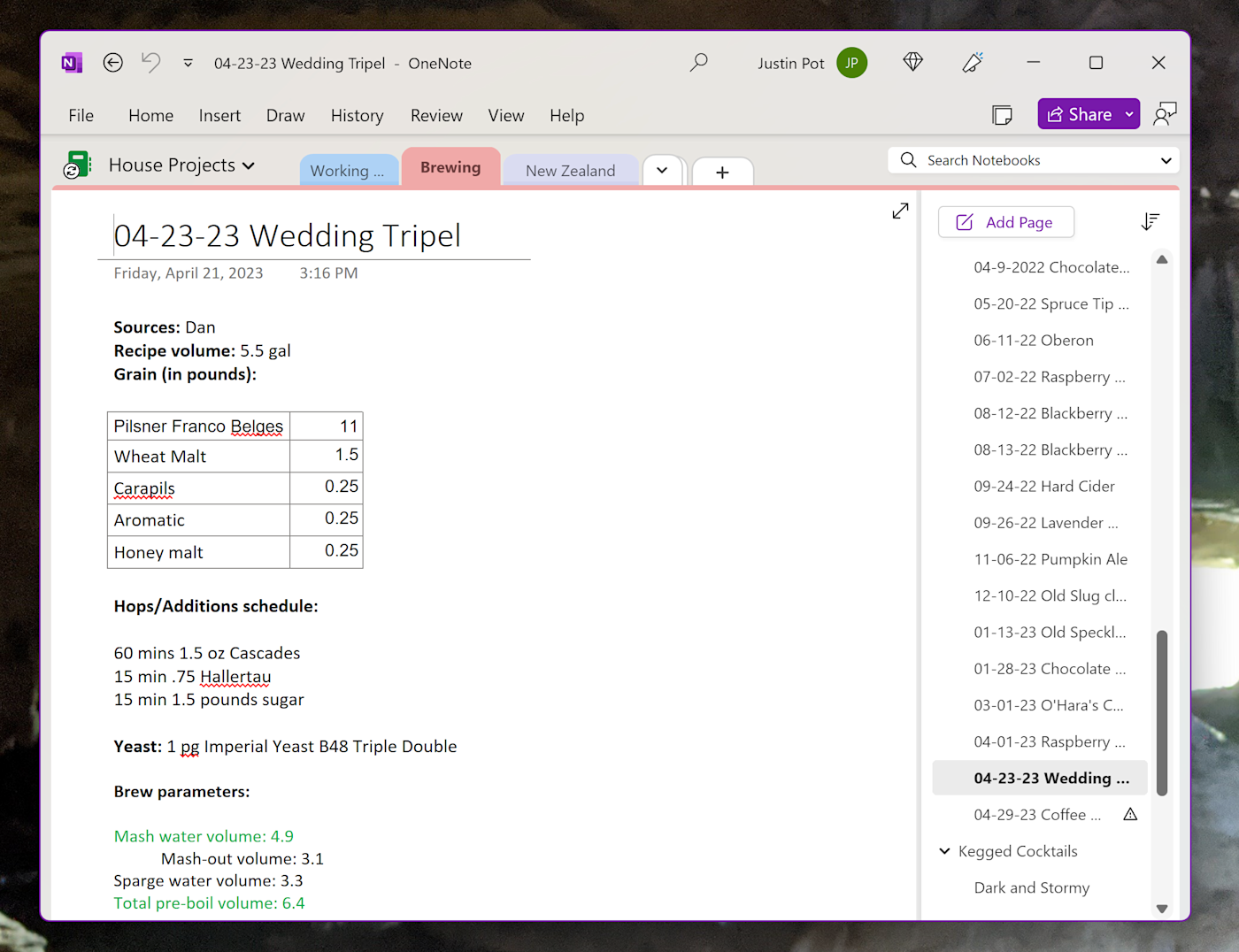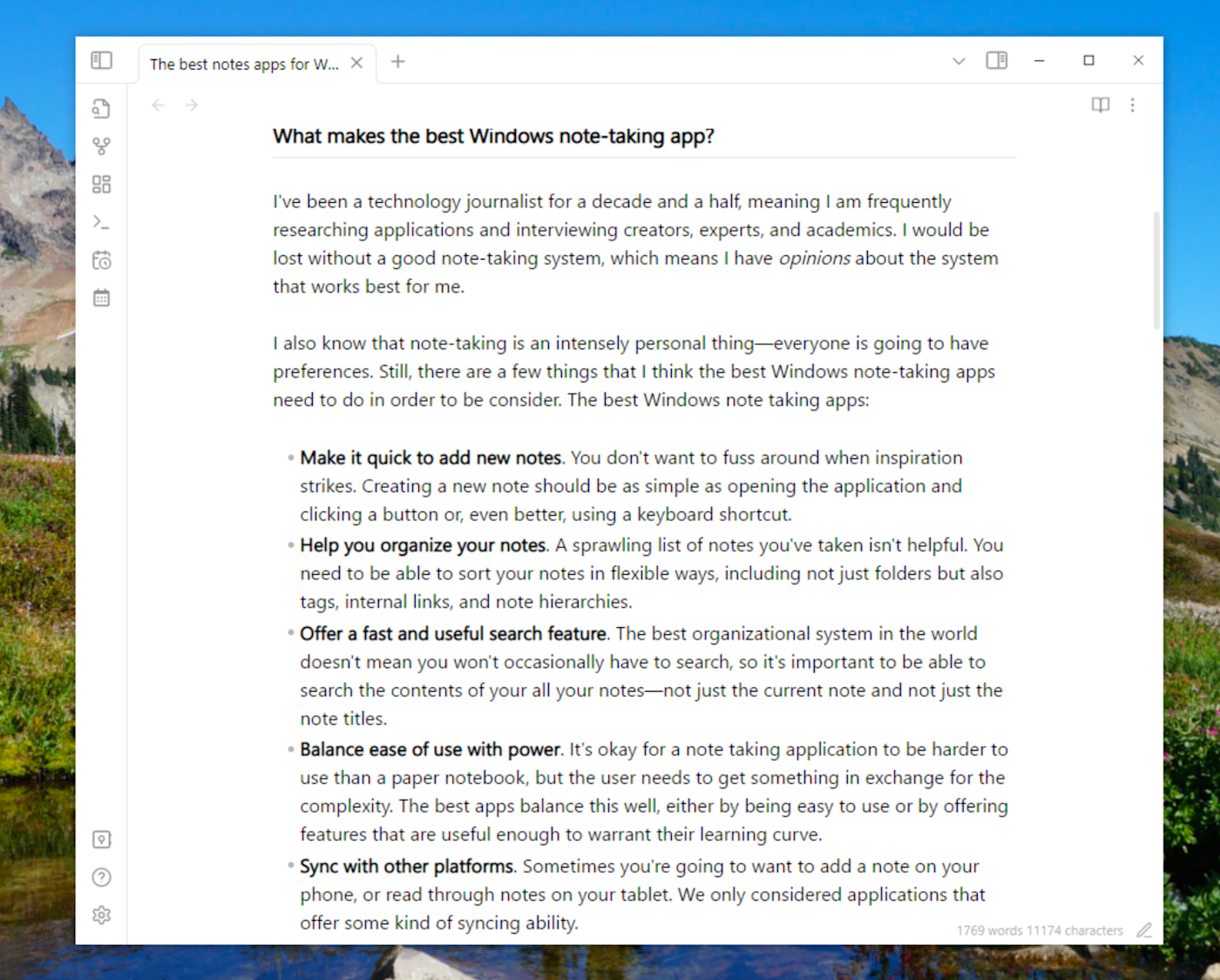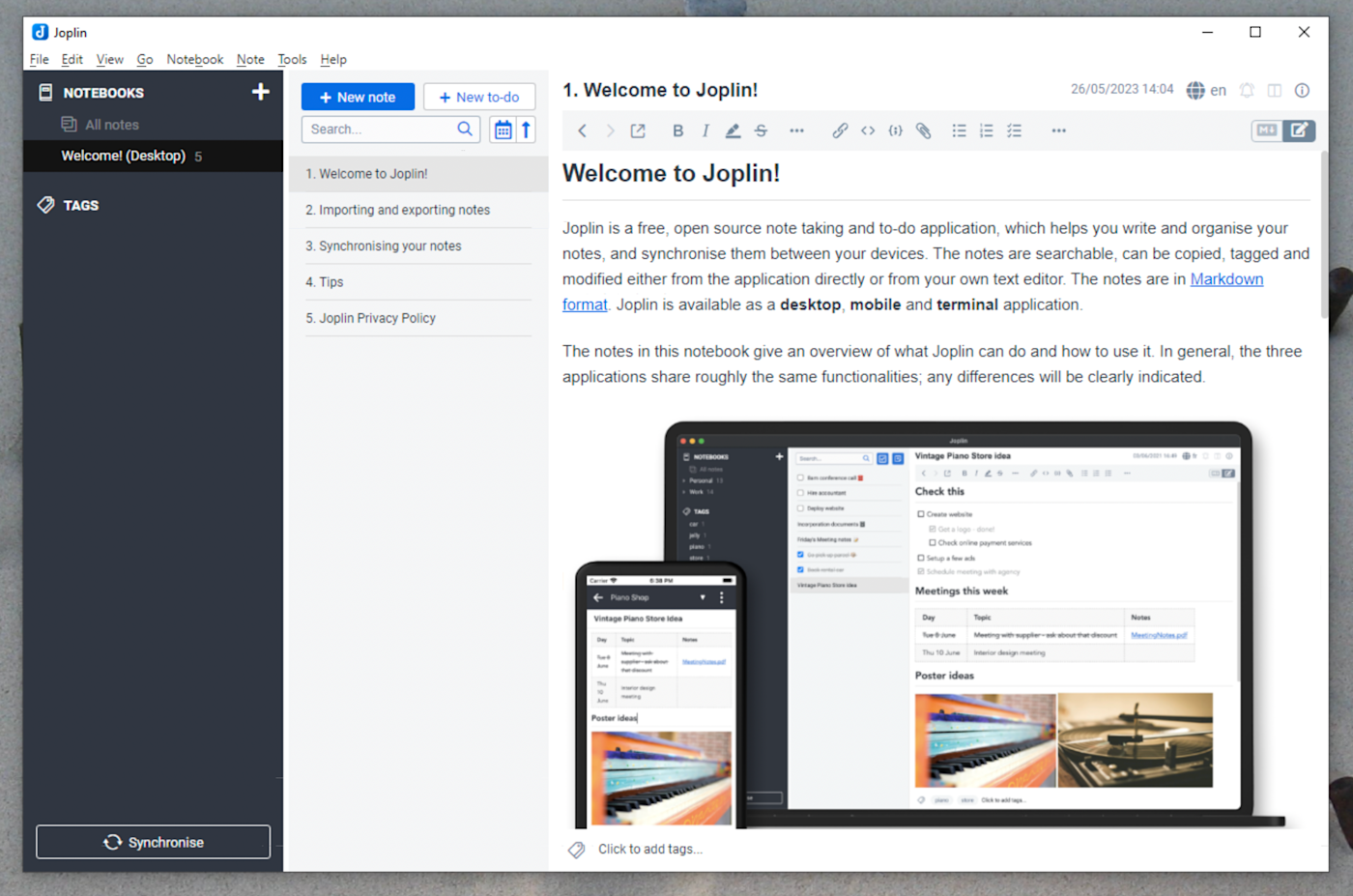Everyone takes notes. Research is pointless, after all, if you're not storing your discoveries somewhere. It doesn't matter if you're writing a dissertation on the non-linear nature of time or just researching which camping spoon to buy—you need somewhere to record your findings in order to reference them later.
But note taking is a very personal thing. Some people are content to take all of their notes in a paper notebook, or in an app that lives in their web browser. Dedicated Windows users, however, are going to want a dedicated Windows application for the job. That's why the best note-taking apps may or may not be the best note-taking apps for Windows specifically: as a Windows user, you have specific needs.
I spent time testing all sorts of note-taking apps for Windows, and these are the ones that fit those needs best for most people.
The best note-taking apps for Windows
OneNote for most people
Obsidian for customization
Simplenote for simplicity
Joplin for an open source option
What makes the best notes app for Windows?
How we evaluate and test apps
All of our best apps roundups are written by humans who've spent much of their careers using, testing, and writing about software. We spend dozens of hours researching and testing apps, using each app as it's intended to be used and evaluating it against the criteria we set for the category. We're never paid for placement in our articles from any app or for links to any site—we value the trust readers put in us to offer authentic evaluations of the categories and apps we review. For more details on our process, read the full rundown of how we select apps to feature on the Zapier blog.
I've been a technology journalist for a decade and a half, meaning I'm frequently researching applications and interviewing creators, experts, and academics. I would be lost without a good note-taking system, which means I have opinions about the system that works best for me.
I also know that note-taking is an intensely personal thing—everyone is going to have preferences. Still, there are a few things that I think the best Windows note-taking apps need to do in order to be considered for a list like this. The best note-taking app for Windows should do the following:
Make it quick to add new notes. You don't want to fuss around when inspiration strikes. Creating a new note should be as simple as opening the app and clicking a button or, even better, using a keyboard shortcut.
Help you organize your notes. A sprawling list of notes you've taken isn't helpful. You need to be able to sort your notes in flexible ways, including not just folders but also tags, internal links, and note hierarchies.
Offer a fast and useful search feature. The best organizational system in the world doesn't mean you won't occasionally have to search, so it's important to be able to search the contents of all your notes—not just the current note and not just the note titles.
Balance ease of use with power. It's ok for a note-taking app to be harder to use than a paper notebook, but the user needs to get something in exchange for the complexity. The best apps balance this well, either by being easy to use or by offering features that are useful enough to warrant their learning curve.
Sync with other platforms. Sometimes you're going to want to add a note on your phone or read through notes on your tablet. I only considered apps that offer some kind of syncing ability.
Are an actual Windows app. Some tools offer a "Windows app" that's really just the web version in a dedicated window. Such apps might work for some people, but for this list, I tried to only consider apps that truly fit in on Windows and offer at least some offline functionality.
I considered around twenty Windows note-taking apps and tested the best options. Based on that experience, here are the four note-taking apps that, in my opinion, best address the needs of Windows users.
Looking for the best note-taking app for another platform? Here are lists of the best note-taking apps for Android, the best note-taking apps for iPad, and the best note-taking apps for Mac.
The best Windows note-taking apps at a glance
Best for |
Stand-out feature |
Pricing |
|
|---|---|---|---|
Most people |
Flexible organization and blank canvas feel |
Free; additional storage available with Microsoft 365 subscription |
|
Customization |
Highly customizable with add-ons and internal linking |
Free for individual use; commercial use requires a license |
|
Simplicity |
Quick and straightforward note-taking |
Free |
|
Open source option |
Local storage with syncing options |
Free; Joplin Cloud subscription available |
The best Windows note-taking app for most people
Microsoft OneNote (Windows, macOS, Android, iOS, Web)

If you want a note-taking app that feels at home on Windows, offers a generous free version, and has just about every feature you can imagine, it's hard to top Microsoft's own OneNote. If you know how to use other Office apps, like Word or Excel, everything about OneNote will feel familiar to you.
It's very easy to open the app and just start typing—and you can do so anywhere on the page. It's like a blank canvas: add text, images, and even doodles anywhere you want.
Organization is also flexible in OneNote. You can create as many notebooks as you want, then break those notebooks into sections, shown as a tab in the interface. You can also create sub-pages, giving you another way to organize notes. The search feature allows you to find things when organization doesn't work, and it can even search inside documents that you attach to your notes.
There are free OneNote apps for every major platform, and syncing is made easy thanks to OneDrive. Note that, for the best experience, you should download the "OneNote" app. Windows 10 came with an app called "OneNote for Windows 10," which offers a stripped-down user interface and is missing key features.
With OneNote's Zapier integration, you can automate OneNote to eliminate the hassle of moving information between apps. For example, Zapier can automatically create new notes in OneNote whenever you have a new task, note, or calendar event in another app.
Microsoft OneNote pricing: Free. Notes are stored in Microsoft OneDrive, which offers 5GB of free storage. For more storage space, you'll need a Microsoft 365 subscription, which starts at $69.99/year for 1TB of storage and access to all Microsoft Office applications, including Word, Excel, and PowerPoint.
The best Windows note-taking app for customization
Obsidian (Windows, macOS, Linux, Android, iOS)

Obsidian is, by far, the most customizable note-taking app a Windows user could ask for. The app, which organizes notes as text documents in a folder on your computer, allows you to manage your notes in nested folders.
You can also add tags to any note and also create internal links between notes. Think of it as a personal wiki. This is great for connecting ideas and projects, and there's even an optional graph view that can visually show you how all of your notes are connected.
Everything about this app is lightning fast, including creating a note and searching your personal library of notes, which is stored entirely on your local hard drive.
The real highlight here, though, is the add-on ecosystem. There are hundreds of tools you can add to Obsidian to make it do just about anything, from offering a Kanban board to embedding videos to integrating with ChatGPT. Check out Obsidian if you have a specific idea of how your ideal note-taking app should work—you can probably create that system with the right add-ons.
Obsidian is offered for all major platforms, and there's an optional paid syncing feature, or you can sync files yourself using practically any cloud storage app.
Obsidian pricing: Free for individual use. Commercial use requires a $50/user/year license.
The best Windows note-taking app for simplicity
Simplenote (Windows, macOS, Android, iOS, Linux)

Customization and other features are all well and good, but what if you just want something you can open and quickly add a note?
Simplenote is what you're looking for. From Automattic, the company behind WordPress, Tumblr, and the Day One journal app, Simplenote is exactly what it claims to be: a simple place to put your notes. There's no support for images, or any attachments, and organization is limited to tags. It's quick to write a note, though, and there is complete search.
Simplenote is the closest thing to Apple Notes you can get on a PC—though it's less feature-rich—and it's easy to sync between devices thanks to apps on every other major platform. Even better, it's completely free, even with syncing.
Simplenote pricing: Free
The best open source Windows note-taking app
Joplin (Windows, macOS, Linux, Android, iOS)

Notes are intensely personal, and I understand if you don't want to trust them all to a company that has its own agenda. Joplin is a free and open source application, which among other things, means that all of your notes live on your computer under your control.
You don't need an account to get started: just download the app and start typing. If you want to sync, you've got options: you can pay for Joplin Cloud, and practically any cloud storage app will work. Dropbox, OneDrive, or the open source Nextcloud are all supported, and you can enable end-to-end encryption if you don't want third-party services to have access.
The interface is that of a traditional note-taking app, with notebooks and notes organized in the left column. You can also organize notes using tags, if you want, and you can clip articles from the web using the web clipper. The main editor is in Markdown, but there's an optional rich text editor if you prefer. There's also support for opening notes in external apps, if you have a favorite Markdown editor.
I recommend Joplin if you find Obsidian too complex but still want notes stored locally on your computer. It's a nice compromise.
Joplin pricing: Free. Joplin Cloud, the official syncing service, starts at 4.79€/month with 10GB of storage space.
Do you need a Windows note-taking app?
It's possible none of these solutions will be quite right for you, given how personal note-taking is—and there are other options.
You could stick to the Sticky Notes app that comes with Windows.
You could just use a series of Word documents.
If you're taking notes mostly as a journal, you could use a journaling app.
You could go with a web app—sometimes it's more important that it works how you want it to, even if it's not a native app.
Related reading:

